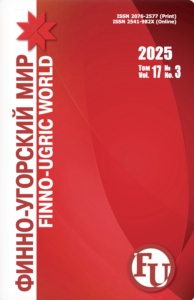Original article
DOI: 10.15507/2076-2577.013.2021.02.124-135
Nadezhda N. Timerkhanova
Udmurt State University,
Izhevsk, Russia
Introduction. In the Udmurt language, bisubjective sentences with absolute polypredicative constructions are very productive. The main components of such constructions are expressed by the noun in the nominative case and the gerundium adverbial or gerundium noun, which are connected by a specific connection. The purpose of this article is to establish the syntactic features of polypredicative constructions. Research objectives are to describe the syntactic structure of such constructions, to establish the type of syntactic connection between the main components within the absolute constructions and to show its difference from the types of syntactic connection traditionally distinguished in the sentence.
Materials and Methods. The main source of the research was the materials from the Udmurt literature and colloquial speech. The author used a set of such research methods as: descriptive method, continuous sampling, contextual analysis, linguistic modeling and transformation. The use of these methods allowed considering the specifics of the units under consideration on a specific language material.
Results and Discussion. In the system of the Udmurt language, absolute polypredicative constructions are widely represented. Namely, gerundium adverbial constructions and gerundium noun constructions that have their own subject of action, which are different from the subject of action of the main part of the sentence – the subject, which is associated with the predicate. The syntactic connection between the subject and the gerundium adverbial part (gerundium noun) is specific, not predicative and not subordinate; it has not yet been designated with the help of a linguistic term in Udmurt linguistics. Such constructions have a fixed word order. In verbs with the gerundium adverbial part on the suffix -sa, there can be no autonomous subject of action, the subject is always the same for the verb-predicate and the gerundium adverbial part.
Conclusion. In the Udmurt language, there are bisubjective constructions with the second subject of action in the nominative case, which claims to be the subject in a polypredicative construction with the main word being a gerundium adverbial or gerundium noun. The syntactic connection between the main components within an absolute constructions differs from the types of syntactic relationship traditionally distinguished in a sentence. This connection can be described as “semi-predictive coordination” or “subpredicative coordination”.
Keywords: the Udmurt language, besubject construction, polypredicative connection, the absolute construction, structural scheme polypredicative construction, semi-predicative/subpredicative coordination
For citation: Timerkhanova NN. Syntactic structure of absolute construction and the connection between its main components in the Udmurt language. Finno-ugorskii mir = Finno-Ugric World. 2021;13;2:124–135. (In Russ.). DOI: 10.15507/2076-2577.013.2021.02.124-135.
Information about the author
N. N. Timerkhanova – Candidate Sc. {Philology}, Head of the Department of Linguistic Typology and Linguodidactics, Udmurt State University,
timer-nadezhda@yandex.ru, https://orcid.org/0000-0002-2331-9239






















